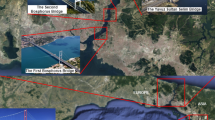Abstract
Damage detection is essential for condition assessment of serviceability and safety of bridges. Different methods have been developed for damage detection based on static or dynamic response of bridges, among which curvature-based method attracted more and more attention as it shed light on accurate detection of damage location. Although there are many investigations contributed to this method, few of them considered the effect of measurement noise and approaches to minimize noise effect. In this paper, effect of measurement noise is investigated in the curvature-based damage detection. An approach is proposed to minimize noise effect for practical application on realistic cases. To verify its reliability and efficacy, laboratory experiment is conducted on a beam specimen, and the measured displacement is used to identify damage with the proposed approach. To illustrate the applicability for realistic bridges, this method was applied to a detailed Finite Element bridge model which also considers effects of measurement noise. The results indicate the feasibility of this method in practical application on girder bridges.















Similar content being viewed by others
References
Doebling SW, Farrar CR, Prime MB, Shevitz DW (1996) Damage identification and health monitoring of structural and mechanical systems from changes in their vibration characteristics: a literature review. Los Alamos, NM: LA-13070-MS, UC-900, Los Alamos National laboratory
Cruz PJS, Salgado R (2009) Performance of vibration-based damage detection methods in bridges. Comput Aided Civ Inf 24(1):62–79
Chang PC, Flatau A, Liu SC (2003) Review paper: health monitoring of civil infrastructure. Struct Health Monit 2(3):257–267
Peeters B, Maeck J, DeRoeck G (2001) Vibration-based damage detection in civil engineering: excitation sources and temperature effects. Smart Mater Struct 10(3):518–527
Soyoz S, Feng MQ (2009) Long-term monitoring and identification of bridge structural parameters. Struct Health Monit 10(6):559–572
Gomez HC, Fanning PJ, Feng MQ, Lee S (2011) Testing and long-term monitoring of a curved concrete box girder bridge. Eng Struct 33(10):2861–2869
Cross EJ, Koo KY, Brownjohn JMW, Worden K (2013) Long-term monitoring and data analysis of the Tamar Bridge. Mech Syst Signal Process 35(1):16–34
Sanayei M, Onipede O (1991) Damage assessment of structures using static test data. AIAA J 29:1174–1179
Banan MR, Banan MR, Hjelmstad KD (1994) Parameter estimation of structures from static response. I: Computational aspects. J Struct Eng ASCE 120:3243–3258
Banan MR, Banan MR, Hjelmstad KD (1994) Parameter estimation of structures from static response. II: Numerical simulation studies. J Struct Eng ASCE 120:3259–3283
Choi IY, Lee JS, Choi E, Cho HN (2004) Development of elastic damage load theorem for damage detection in a statically determinate beam. Comput Struct 82:2483–2492
Farrar CR, Jauregui DA (1998) Comparative study of damage identification algorithms applied to a bridge. Smart Mater Struct 7:704–719
Yam LH, Li YY, Wong WO (2002) Sensitivity studies of parameters for damaged erection of plate-like structures using static and dynamic approaches. Eng Struct 241:1465–1475
Goldfeld Y (2014) Curvature rate approach to the evaluation of the stiffness distribution in plate-like structures. J Sound Vib 333:4483–4498
Lee U, Shin J (2002) A structural damage identification method for plate structures. Eng Struct 24:1177–1188
Wu D, Law SS (2004) Damage localization in plate structures from uniform load surface curvature. J Sound Vib 276:227–244
Choi S, Park SY, Yoon SW, Stubbs N (2005) Nondestructive damage identification in plate structures using changes in modal compliance. NDT&E Int 38:529–540
Bayissa WL, Haritos N (2007) Structural damage identification in plates using spectral strain energy analysis. J Sound Vib 307:226–249
Shi ZY, Law SS, Zhang LM (1998) Structural damage localization from modal strain energy change. J Sound Vib 218(5):825–844
Timoshenko SP (1955) Strength of materials. D.Van Nostrand Company, New York
Timoshenko SP, Goodier JN (1951) Theory of elasticity. McGRAW-Hill Book Company, New York
Acknowledgments
The financial support from the University of Tokyo is hereby kindly acknowledged. The authors greatly acknowledge the valuable advices from Prof. Di Su from The University of Tokyo and Dr. Dionysius from Yokohama National University during the research. The first author also would like to express gratitude to Japanese Ministry of Education, Culture, Sports, Science and Technology for its scholarship support during his doctoral course.
Author information
Authors and Affiliations
Corresponding author
Rights and permissions
About this article
Cite this article
Sun, Z., Nagayama, T. & Fujino, Y. Minimizing noise effect in curvature-based damage detection. J Civil Struct Health Monit 6, 255–264 (2016). https://doi.org/10.1007/s13349-016-0163-x
Received:
Accepted:
Published:
Issue Date:
DOI: https://doi.org/10.1007/s13349-016-0163-x




